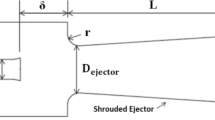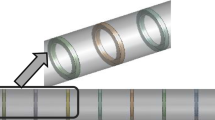Abstract
The detonation combustion phenomenon is supersonic combustion process and follows on thermal explosion in combustor. Deflagration to detonation transition occurs in detonation tube due to pressure oscillation in PDE combustor, which is driven by acoustic combustion phenomena in detonation tube. As this combustion process has great significance role for future propulsion system, the present objective is to investigate the effect of modify ejector having half angles of α = (− 4°, 0°, + 4°) on detonation combustion wave propagation regime. Further the propulsion thrust of liquid kerosene and gaseous hydrogen–air mixture are also analyzed. This numerical simulation has been analyzed by LES turbulence model for DDT and shock wave pressure oscillation in pulse detonation combustor at Fluent based CFD plat form. The one-step irreversible chemical kinetics model analyzes the details exothermic chemical reaction mechanism inside the combustor. However, the shrouded ejector with taper angle of α = +4° performed the strong starting vortex generation and shortest possible time of 0.032 s for fully developed detonation wave. The simulation results also shows that thrust force augmentation of hydrogen–air mixture is greater compared to combustion process of liquid kerosene–air mixture with significant magnitude of 38 N. Although kerosene–air mixture produces less pollutant number but the propagation flame velocity is 2550 m s−1 for hydrogen/air mixture, which is near about C–J velocity and comparatively higher than kerosene/air combustion process.












Similar content being viewed by others
Abbreviations
- Ma:
-
Mach number
- d :
-
Diameter
- D th :
-
Throat diameter
- L :
-
Length
- t :
-
Time
- s :
-
Second
- ρ :
-
Density
- µ :
-
Kinematic viscosity
- p :
-
Pressure
- T:
-
Temperature
- h :
-
Enthalpy
- e :
-
Internal energy
- m :
-
Mole concentration
- ϕ :
-
Equivalent ratio
- α :
-
Taper angel
- Y i :
-
Mass fraction
- CFD:
-
Computational fluid dynamics
- CEA:
-
Chemical equilibrium and applications
- CJ:
-
Chapman Jouguet
- PDE:
-
Pulse detonation engine
- LES:
-
Large eddy simulation
- DDT:
-
Deflagration to detonation transition
References
Bussing T, Pappas G. An introduction to pulse detonation engines. AIAA paper no. 94-0263. 1994.
Pandey KM, Debnath P. Reviews on recent advances in pulse detonation engines. J Combust. 2016; Article ID 4193034.
Kuo KK. Principles of combustion. New York: Wiley; 1986.
Zheng F, Kuznetsov AV, Robarts WL, Pazson DE. Influence of geometry on starting vortex and ejector performance. J Fluids Eng. 2011;133:051204-1.
Allgood D, Gutmark E, Hoke J, Bradley R, Schauer F. Performance studies of pulse detonation engine ejectors. J Propul Power. 2008;24(6):1317–23.
Changxin P, Wei F, Qun Z, Cheng Y, Wenjuan C, Chuanjun Y. Experimental study of an air-breathing pulse detonation engine ejector. Exp Therm Fluid Sci. 2011;35:971–7.
Yungster S, Paxson DE, Perkins HD. Numerical investigation of shrouded ejector-enhanced pulse combustor performance at high pressure. J Propul Power. 2017;33(1):29–42.
Paxson DE, Dougherty KT. Ejector enhanced pulsejet based pressure gain combustors: an old idea with a new twist. AIAA paper 2005-4216, July, 2005.
Heer JJH, Miller RJ, Freeman C. The time-resolved flow within an ejector driven by a sinusodially unsteady jet. In: 46th AIIA aerospace science meeting and exhibit, vol. AIAA-2008-117, Reno, Navada, January 2008, American Institute of Aeronautics and Astronautics.
Gharib M, Rambod E, Shariff K. A universal time scale for vortex ring formation. J Fluid Mech. 1998;10:121–40.
Archer PJ, Thomas TG, Coleman GN. Direct numerical simulation of vortex ring evolution from the laminar to the early turbulent regime. J Fluid Mech. 2008;598:201–26.
Arakeri JH, Das D, Krothapalli A, Lourenco L. Vortex ring formation at the open end of a shock tube: a particle image velocimetry study. Phys Fluids. 2000;16(4):1008–19.
Wan Q, Roberts WL, Kuznetsov AV. Computational analysis of the feasibility of a micro-pulsejet. Int Commun Heat Mass Transf. 2005;32:19–26.
Ettner F, Vollmer KG, Sattelmayer T. Numerical simulation of the deflagration-to-detonation transition in inhomogeneous mixtures. J Combust. 2014;Paper ID 686347.
Liang D, Liu J, Xiao J, Xi J, Wang Y, Zhou J. Effect of metal additives on the composition and combustion characteristics of primary combustion products of B-based propellants. J Therm Anal Calorim. 2015;122:497–508.
Nguyen VB, Teo CJ, Chang PH, Li JM, Khoo BC. Numerical investigation of the liquid-fueled pulse detonation engine for different operating conditions. Shock Waves. 2019;29:1205–25.
Mukhopadhyay A, Datta S, Sanyal D. Effects of tailpipe friction on the nonlinear dynamics of a thermal pulse combustor. J Eng Gas Turbines Power. 2008;130(1):1–9.
Li J, Fan W, Yan C, Li Q. Experimental investigation on detonation initiation in a kerosene–oxygen pulse detonation engine. Combust Sci Technol. 2009;181:417–32.
Shaikh T, Patidar L, Chowdhury A. Experimental and numerical investigation of combustion in a hydrocarbon and gaseous oxygen fuelled rocket. Appl Therm Eng. 2017;110:1554–67.
Frolov SM, Aksenov VS, Ivanov VS, Shamshin IO. Continuous detonation combustion of ternary hydrogen–liquid propane–air mixture in annular combustor. Int J Hydrog Energy. 2017;42(26):16808–20.
Debnath P, Pandey KM. Numerical investigation of detonation combustion wave in pulse detonation combustor with ejector. J Appl Fluid Mech. 2017;10(2):725–33.
Zhang B, Liu H, Wang C. Detonation velocity behavior and scaling analysis for ethylene-nitrous oxide mixture. Appl Therm Eng. 2017;127:671–8.
Alhussan K, Assad M, Penazkov O. Analysis of the actual thermodynamic cycle of the detonation engine. Appl Therm Eng. 2016;107:339–44.
Zheng F. Ph.D. thesis, Computational investigation of high speed pulsejets, Raleigh, North Carolina, 17 Aug 2009.
Debnath P, Pandey KM. Exergetic efficiency analysis of hydrogen–air detonation in pulse detonation combustor using computational fluid dynamics. Int J Spray Combust Dyn. 2017;9(1):44–54.
Zhao S, Fan Y, Lv H, Jia B. Effects of a jet turbulator upon flame acceleration in a detonation tube. Appl Therm Eng. 2017;115:33–40.
Dzieminska E, Hayashi AK. Auto-ignition and DDT driven by shock wave boundary layer interaction in oxyhydrogen mixture. Int J Hydrog Energy. 2013;38:4185–93.
Dong H, Zan W, Hong T, Zhang X. Numerical simulation of deflagration to detonation transition in granular HMX explosive under thermal ignition. J Therm Anal Calorim. 2017;127(1):975–81.
ANSYS. ANSYS fluent 14.0 theory guide. Canonsburg: ANSYS Inc; 2011.
Ezoji H, Shafaghat R, Jahanian O. Numerical Simulation of dimethyl ether/natural gas blend fuel HCCI combustion to investigate the effects of operational parameters on combustion and emission. J Therm Anal Calorim. 2019;135(3):1775–85.
Glaser AJ. Performance and environmental impact assessment of pulse detonation based engine systems. Ph. D. thesis, Division of Research and Advanced Studies of the University of Cincinnati, Department of Aerospace Engineering; 2007.
Card J, Rival D, Ciccarelli G. DDT in fuel–air mixtures at elevated temperatures and pressures. Shock Waves. 2005;14(3):167–73.
Noor Alam, Sharma KK, Pandey KM. Combustion characteristics of hydrogen-air mixture in pulse detonation engines. J. Mech. Sci. Technol. 2019;33(5):2451–7.
Acknowledgements
The authors would like to express gratitude to the Mechanical Engineering Department, NIT Agartala, Tripura: 799046, India, for providing the computer facilities.
Author information
Authors and Affiliations
Corresponding author
Additional information
Publisher's Note
Springer Nature remains neutral with regard to jurisdictional claims in published maps and institutional affiliations.
Rights and permissions
About this article
Cite this article
Debnath, P., Pandey, K.M. Numerical analysis of detonation combustion wave in pulse detonation combustor with modified ejector with gaseous and liquid fuel mixture. J Therm Anal Calorim 145, 3243–3254 (2021). https://doi.org/10.1007/s10973-020-09842-1
Received:
Accepted:
Published:
Issue Date:
DOI: https://doi.org/10.1007/s10973-020-09842-1




